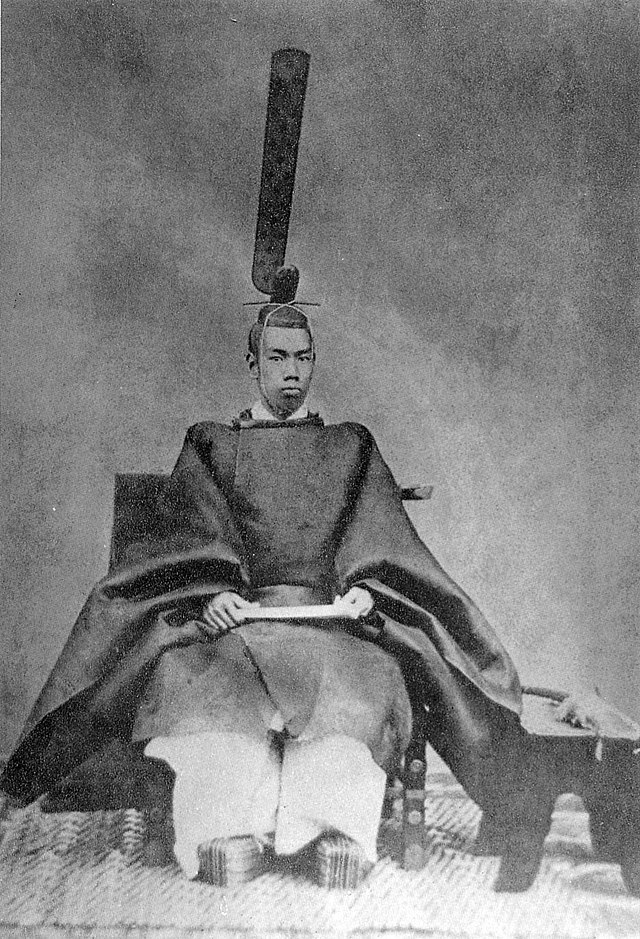Meiji era: Difference between revisions - Wikipedia
 Article Images
Article Images
Content deleted Content added
Loafiewa 21,946 edits |
m |
||
| (20 intermediate revisions by 13 users not shown) | |||
Line 1: {{short description|Period of Japanese history (1868–1912)}}
{{Use mdy dates|date=June 2020}} {{Use American English|date=June 2020}} Line 12 ⟶ 11: | caption = [[Emperor Meiji]] (1872) | before = [[Keiō]] | including = *[[Japanese invasion of Taiwan (1874)]]
*[[Ganghwa Island incident|Japanese invasion of Korea]] *[[First Sino-Japanese War]] *[[Japanese invasion of Taiwan (1895)]] *[[Eight-Nation Alliance]]▼ *[[Boxer Rebellion]] ▲**[[Eight-Nation Alliance]] *[[Russo-Japanese War]] }}▼ | after = [[Taishō era|Taishō]] | monarch = [[Emperor Meiji|Meiji]] Line 26 ⟶ 27: periods}} The {{Nihongo|'''Meiji era'''|明治時代|Meiji jidai|{{IPA The rapid modernization during the Meiji era was not without its opponents, as the rapid changes to society caused many disaffected traditionalists from the former [[samurai]] class to rebel against the Meiji government during the 1870s, most famously [[Saigō Takamori]] who led the [[Satsuma Rebellion]]. However, there were also former samurai who remained loyal while serving in the Meiji government, such as [[Itō Hirobumi]] and [[Itagaki Taisuke]]. Line 56 ⟶ 57: [[File:Meiji tenno1.jpg|thumb|upright|[[Emperor Meiji]] {{circa|1888}}]]
== Politics == Line 123 ⟶ 124: The [[Industrial Revolution]] in Japan occurred during the Meiji era. The industrial revolution began around 1870 as Meiji era leaders decided to catch up with the West. The government built railroads, improved roads, and inaugurated a land reform program to prepare the country for further development. It inaugurated a new Western-based education system for all young people, sent thousands of students to the United States and Europe, and hired more than 3,000 Westerners to teach modern science, mathematics, technology, and foreign languages in Japan (O-yatoi gaikokujin). In 1871, a group of Japanese politicians known as the [[Iwakura Mission]] toured Europe and the US to learn western ways. The result was a deliberate state-led industrialization policy to enable Japan to quickly catch up. Modern industry first appeared in textiles, including cotton and especially silk, which was based in home workshops in rural areas.<ref>{{Cite book|last=Allen|first=George Cyril|title=A short economic history of modern Japan, 1867-1937|date=1972|publisher=Allen and Unwin|isbn=0-04-330201-7|edition=3rd rev.|location=London|oclc=533080}}</ref> Due to the importing of new textile manufacturing technology from Europe, between 1886 and 1897, Japan's total value of yarn output rose from 12 million to 176 million yen. In 1886, 62% of yarn in Japan was imported; by 1902, most yarn was produced locally. By 1913, Japan was producing 672 million pounds of yarn per year, becoming the world's fourth-largest exporter of cotton yarn.<ref>{{Cite book|title=The Wealth and Poverty of Nations: Why Some Are So Rich and Some So Poor|last=Landes|first=David S.|publisher=Norton|year=1999|location=New York|pages=379–80}}</ref> Line 245 ⟶ 246: {{Clear}} ==Conversion To convert any [[Gregorian calendar]] year between 1868 and 1912 to [[Japanese calendar]] year in Meiji era, 1867 needs to be subtracted from the year in question.▼ ===Before 1873=== Prior to Japan adopting the [[Gregorian calendar]], it used the [[Lunisolar calendar|lunisolar]] Japanese calendar. The first five years of the era correspond to the following date ranges in the Gregorian calendar: {| class="wikitable" |+ Conversion table for the first five years of the Meiji era to the Gregorian calendar ! Meiji year !! Gregorian date range |- | 1 || October 23, 1868 – February 10, 1869 |- | 2 || February 11, 1869 – January 31, 1870 |- | 3 || February 1, 1870 – February 18, 1871 |- | 4 || February 19, 1871 – February 8, 1872 |- | 5 || February 9 – December 31, 1872 ▲ Conversely, the conversion table of Gregorian calendar years 1868 to 1872 to the traditional Japanese lunisolar calendar is shown below: {| class="wikitable" |+ Conversion table of Gregorian calendar years 1868 to 1872 to the Japanese lunisolar calendar ! Gregorian year !! Japanese calendar range |- | 1868 || [[Keiō]] 3/12/7 – Meiji 1/11/18 |- | 1869 || Meiji 1/11/19 – 2/11/29 |- | 1870 || Meiji 2/11/30 – 3/11/10 |- | 1871 || Meiji 3/11/11 – 4/11/20 |- | 1872 || Meiji 4/11/21 – 5/12/2 |} ===Since 1873=== ▲On January 1, 1873, Japan adopted the Gregorian calendar. To convert any {|class="wikitable" style="text-align:center" |- !Meiji |- |AD |- !Meiji |- |AD |- !Meiji|| 33 || 34 || 35 || 36 || 37 || 38 || 39 || 40 || 41 || 42 || 43 || 44 || 45 | |||